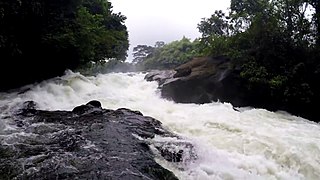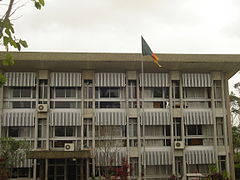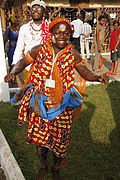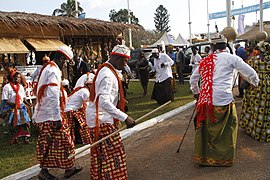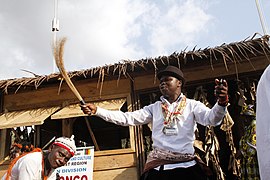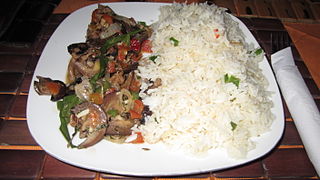Southwest Region (Cameroon)
Southwest Region | |
|---|---|
 Location of Southwest Region within Cameroon | |
| Country | Cameroon |
| Capital | Buea |
| Divisions | Fako, Koupé-Manengouba, Lebialem, Manyu, Meme, Ndian |
| Government | |
| • Governor | Bernard Okalia B. |
| • President of the Regional Assembly & Executive Council | Zacheus Bakoma[1] |
| Area | |
• Total | 25,410 km2 (9,810 sq mi) |
| Population (2015) | |
• Total | 1,553,320 |
| • Density | 61/km2 (160/sq mi) |
| HDI (2022) | 0.676[2] medium · 2nd of 10 |
The Southwest Region or South-West Region (French: Région du Sud-Ouest) is a region with special status in Cameroon. Its capital is Buea.[3] As of 2015, its population was 1,553,320. Along with the Northwest Region, it is one of the two Anglophone (English-speaking) regions of Cameroon. Various Ambazonian nationalist and separatist factions regard the South-West region as being distinct as a polity from Cameroon.[4]


History
In 1884, the region was colonized by Germany under the Protectorate regime until 1916 when it became a condominium administered jointly by the United Kingdom and France.[5] In 1919, the administration of the South West region became solely British. In 1961, the region joined Cameroon as part of the federated state of West Cameroon.[6]
At the end of 2017, an Ambazonian separatist movement in the two English-speaking regions of the North-West and South-West initiated a wave of violence affecting the military, police, business leaders and workers. The separatist militiamen are trying in particular to prevent children from returning to school. Between 2016 and 2019, separatists reportedly ransacked, destroyed or burned more than 174 schools[7] Separatists from the Ambazonia administration regard both the Northwest and Southwest regions as being constituent components of their envisaged breakaway state.[8]
Administration

The region is divided into six divisions or departments: Fako, Koupé-Manengouba, Lebialem, Manyu, Meme and Ndian. These are in turn broken down into subdivisions.[9] Presidentially appointed senior divisional officers (prefets) and subdivisional officers (sous-prefets) govern each respectively.
Special status
As part of the Major National Dialogue, the region was given a "special status" in December 2019, granting additional rights and responsibilities in relation to economic, health, social, educational, sports and cultural development.[10][11] Under the special status the region has a bicameral Regional Assembly, made up of a 20-member House of Chiefs composed of traditional leaders and a 70-member House of Divisional Representatives nominated by municipal councils. The Regional Assembly appoints a Regional Executive Council.[12] Additional powers over health and education were also granted to municipalities.[13]
Regional Executive Council
The Regional Executive Council is led by the President of the Regional Assembly and includes a vice president, three commissioners, two secretaries and a questor.[12] The first committee, elected in December 2020, was as follows:[14]
| Name | Portfolios |
|---|---|
| Bakoma Elango Zacheus | President of the Regional Assembly President of the House of Divisional Representatives President of the Regional Executive Council |
| Atem Ebako | Vice-President of the Regional Assembly President of the House Chiefs Vice-President of the Regional Executive Council |
| Mokoko Simon Gobina | Commissioner for Economic Development |
| Itoe Williams Elangwe | Commissioner for Security and Social Development |
| Taking Walters Ayuk | Commissioner for Education, Sports and Cultural Development |
| Limunga Becky Effoe | Secretary |
| Chief Foto Felix | Secretary |
| Tazie Andrew | Questor |
Geography
The region was notable for having the first English-speaking university in Cameroon (the University of Buea). Towns include the capital Buea, Limbe, Tiko, Kumba and Mamfe. Limbe in particular is a popular tourist resort notable for its fine beaches. Korup National Park is also a major attraction. Buea itself, meanwhile, sits at the foot of Mount Cameroon, and possesses an almost temperate climate markedly different from the rest of the province.
|
Culture
The province is largely Anglophone and Protestant Christian.[15]
|
Common dishes in the region
|
Demographics
| Year | Pop. | ±% p.a. |
|---|---|---|
| 1976 | 620,515 | — |
| 1987 | 838,042 | +2.77% |
| 2005 | 1,316,079 | +2.54% |
| 2015 | 1,553,320 | +1.67% |
| source:[16] | ||
Healthcare
References
- ^ https://cameroonnewsagency.com/govt-to-secure-1-billion-for-south-west-regional-assembly-edifice/
- ^ "Sub-national HDI - Area Database - Global Data Lab". hdi.globaldatalab.org. Retrieved 2018-09-13.
- ^ "BUEA". cvuc.cm (in French). Archived from the original on 1 July 2020. Retrieved 2017-08-07.
- ^ Tatah-Mentan, I., and F. Achankeng. "Stopping war before it starts: testing preventive diplomacy in the selfdetermination case of British Southern Cameroons (aka Ambazonia)." British Southern Cameroons: Nationalism & Conflict in Postcolonial Africa (2014): 127-170.
- ^ Emmanuel Mbah, Environment and Identity Politics in Colonial Africa: Fulani Migrations and Land Conflict, Taylor & Francis, UK, 2016, p. 20
- ^ Emmanuel Mbah, Environment and Identity Politics in Colonial Africa: Fulani Migrations and Land Conflict, Taylor & Francis, UK, 2016, p. 21
- ^ Philippe Karsenty, in Cameroon, causeur.fr, September 2, 2019
- ^ Adepoju, Paul. "World Report Hospital attack in anglophone Cameroon kills four patients." (2019).
- ^ "Région du Sud-Ouest". cvuc.cm (in French). Retrieved 2017-08-07.
- ^ https://www.reuters.com/article/world/cameroon-grants-special-status-to-anglophone-regions-idUSKBN1YO24I/
- ^ "Cameroon MPs Approve Law Giving Special Status to English-Speaking Regions". Voice of America. 2019-12-21. Retrieved 2024-10-08.
- ^ a b "Comprendre la Région CTDEN". Ministère de la Décentralisation et du Devellopement Local (in French). 2020-11-25. Retrieved 2024-10-08.
- ^ Bone, R. Maxwell (2020-01-13). "Cameroon grants 'special status' its to restive regions. They don't feel special". African Arguments. Retrieved 2024-10-08.
- ^ "Cameroon: First-Ever South West Regional Council Session Takes Place - PAN AFRICAN VISIONS". panafricanvisions.com. 2020-12-22. Retrieved 2024-10-08.
- ^ "Cameroon". www.state.gov. Archived from the original on 19 October 2011. Retrieved 12 January 2022.
- ^ Cameroon: Administrative Division population statistics









